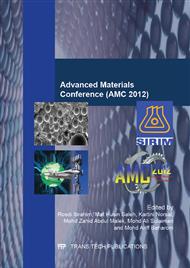p.73
p.79
p.85
p.90
p.96
p.102
p.107
p.112
p.119
Photo Characterization of Spirooxazine and Naphthopyran Organic Dyes upon UV Irradiation
Abstract:
Organic dyes namely 1,3,3-trimethylindolino-naphtospirooxazine (TINS) and 3,3-diphenyl-3H-napthol [2,1-pyran DNP) were used in studies of photochromic transformation in ethanol solution. The samples were exposed to UV light ranging from 5, 10 and 15s respectively. TINS absorbs UV light at 613nm for multiple exposure time. The absorption initiated the opening of oxazine spirostructure with formation of open merocyanine species. Irradiation of DNP with UV at 5, 10 and 15s absorbs at 413nm with formation of opening cyclicstucture of naphthopyran, namely allenyl-naphtol. The intensity peaks of TINS and DNP were increased with increasing the period of irradiation time. TINS and DNP dyes exhibit normal photochromic in the polar protic solvent by displaying color changes form transparent to color blue and light orange under exposed UV light. The photochromic activity of these compounds is due to the reversible light-induced cleavage of the C-O bond between the heterocyclic oxygen atom and the quaternary carbon.
Info:
Periodical:
Pages:
96-101
Citation:
Online since:
January 2014
Keywords:
Price:
Сopyright:
© 2014 Trans Tech Publications Ltd. All Rights Reserved
Share:
Citation:


